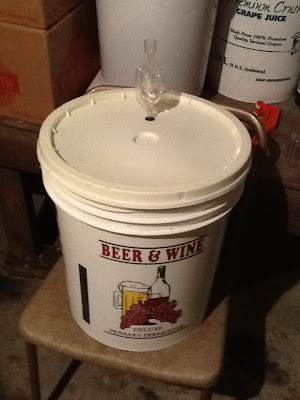As the resident brewer here at SteffesWood Apiary, I was assigned to test the Executive Branch's effort. The Honey Ale is roughly equivalent to a British ESB (Extra Special Bitter), a full bodied amber beer with a 7% alcohol content.
New to brewing? If you can make soup, you can brew beer, though you'll obviously require some specialized equipment that will run you $100-150. A good tutorial on basic technique can be found at How to Brew. Beginner's kits and ingredients can be purchased in the Pittsburgh area at one of South Hills Brewing's locations. There are plenty of on-line sources available as well, including Northern Brewer Home Brew Supply, which has already put together an ingredients kit.
Here is the recipe from the White House website:

And here is how I brewed it:
 |
| All the ingredients |
2. Malt extract in both its forms is used. You can add both now or just the dry stuff and add the liquid 15 minutes before the end of the boil. Be careful to stir the liquid extract enough when added to put it in solution or it will burn on the bottom.
 |
| Steeping the grains |
A word of warning: don't let the pot out of your sight during the boil if you want to avoid a sticky mess on your stove! Don't ask me how I know this! Stir frequently.
 |
| plug hops (left) and leaf hops (right) |
5. I added the honey with the Fuggles as I wanted to preserve the delicate aromatics of that fine SteffesWood honey as much as possible. My experience with brewing is that honey does not contain any microbes that will spoil the beer so it doesn't need to be sterilized.
 |
| cooling wort in ice bath |
6. You want to cool the wort as rapidly as possible down to the temp you can safely add yeast, about 80 degrees F. I put the pot in an ice bath in the sink, then pour the cooled wort into the fermenter with enough chilled spring water to bring the volume up to 5 gallons.
 |
| pitching the yeast |
7. The recipe calls for Windsor dry yeast, a typical English ale yeast that will impart a fruity taste to the end product. I used Safale S-04, a similar product. All you need to do to "pitch" the yeast is make sure the wort is not too hot, sprinkle it in, close the lid (and block the airlock hole) and give the bucket a good shaking. The yeast is aerobic and needs to have air incorporated in the wort to do its work of breaking the sugars down into CO2 and alcohol. Fit the airlock and open up a beer to celebrate all your hard work.
8. I ferment in the basement, where the temperature is a constant 68 degrees. Ale yeast is pretty flexible and will work well over a wide range.
9. You don't need to use a secondary fermenter, though I often do. You can leave it in the same bucket for a couple weeks until there is just one bubble a minute coming out of the airlock. If you have a hydrometer, the beer is fermented out when the final gravity is 1.020 ( the starting gravity is about 1.060)








